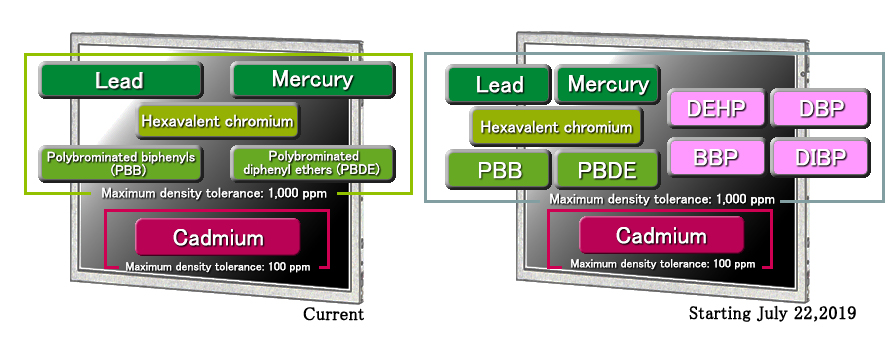Chemical Substances Contained in Products System
Our products are RoHS compliant
The European Union (EU) issued a RoHS Directive,*1 taking effect from July 1, 2006, that restricts the use of certain hazardous substances. As a result, electrical and electronic equipment containing any of the six target substances (lead, mercury, cadmium, hexavalent chromium, PBB*2 and PBDE*3) is restricted from the EU market.
Out of concern for the environment, NLT Technologies began reducing the use of hazardous substances in our LCD modules prior to the RoHS directive. We have eliminated the six substances targeted in the RoHS directives as well as other substances we have identified as potentially hazardous, so that our products are now RoHS compliant.
The RoHS Directive underwent major revisions in July 2011. The updated RoHS Directive (RoHS II) went into effect in January 2013.
In June 2015, the Official Journal of the European Union also announced that the number of restricted substances would grow from six to ten substances and that the addition of restrictions on four phthalates*4 would enter into effect on July 22, 2019.*5 We remain committed to meeting all RoHS II requirements, including restrictions on phthalic acids.

*1 RoHS: The Restriction Of The Use Of Certain Hazardous Substances In Electrical And Electronic Equipment
*2 PBB: Poly brominated biphenyl
*3 PBDE: Poly brominated diphenyl ether
*4 Four phthalates
- DEHP: Bis(2-ethylhexyl)phthalate
- DBP: Dibutyl phthalate
- BBP: Butyl benzyl phthalate
- DIBP: Diisobutyl phthalate
*5 The restriction shall not apply to monitoring and control instruments placed on the market before 22 July 2021.
Compliance with chemical substances restriction (REACH regulations)
In place from June 1, 2007, the EU REACH*6 regulations require the registration, evaluation, and authorization of all chemical substances entering the EU, based on factors such as volumes imported or produced.
For molded products containing substances of very high concern (SVHC*7) and SVHC candidates in concentrations of 0.1% or more, a system must be in place throughout the supply chain to communicate information such as substance names, volumes included, and information enabling safe use.
To comply with REACH regulations, we are currently developing a management system that incorporates BOM*8 management of the parts and materials used in products, surveys of the chemical ingredients used therein, and processing of the data collected.
*6 REACH : Registration, Evaluation, Authorization and Restriction of Chemicals
*7 SVHC : Substances of Very high Concern
*8 BOM: Bill of Materials


